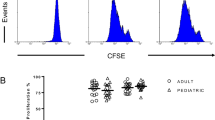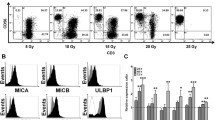Abstract
In this study we have established culture conditions that allow the preferential and rapid expansion of either T cell receptor (TCR)+/CD3+16− T lymphocytes or TCR−/CD3−16− natural killer (NK) cells, or the non-selective outgrowth of both subsets. Optimal proliferation of lymphocytes was obtained using a combination of irradiated allogeneic peripheral blood lymphocytes (PBL) and irradiated Epstein Barr virus (EBV) transformed lymphoblastoid B cell lines (B-LCL). Addition of 1μg/ml leucoagglutinin to the culture medium induced a preferential outgrowth of TCR−/CD3−16− T lymphocytes. The proportion of TCR−/CD3−16− NK cells was decreased to 5% or less, although still a 2000-fold multiplication of TCR−/CD3−16− NK cells was obtained at day 13. Without leucoagglutinin a 1000-fold increase of about 70% pure TCR−/CD3−16− NK cells was obtained at day 13. Intermediate concentrations of leucoagglutinin (0.1–0.3μg/ml) resulted in a non-selective expansion of both NK cells and T cells. Irrespective whether leucoagglutinin was added or not, the number of TCR+/CD3+8+ lymphocytes increased more rapidly relative to the TCR+/CD3+4+ lymphocytes resulting in an increased TCR+/CD3+8+ population size.
Also under limiting dilution conditions leucoagglutinin increased the frequency of proliferating cells. In contrast to the preferential outgrowth of TCR+/CD3+8+ lymphocytes in bulk cultures, approximately 80% of the clones generated was TCR+/CD3+4+, demonstrating a growth promoting effect of TCR+/CD3+4+ lymphocytes on TCR+/CD3+8+ lymphocytes in PBL bulk cultures.
Similar content being viewed by others
References
Chatila TA, Schwartz DH, Miller R, Geha RS. Requirement for mitogen, T cell-accessory cell contact, and interleukin 1 in the induction of resting T cell proliferation. Clin Immunol Immunopathol 1987; 44: 235–47.
Van Wauwe JP, Goossens JG. OKT3: a monoclonal antihuman T lymphocyte antibody with potent mitogenic properties. J Immunol 1980; 124: 2708–13.
Anderson P, Blue ML, Morimoto C, Schlossman SF. Cross-linking of T3 (CD3) with T4 (CD4) enhances the proliferation of resting lymphocytes. J Immunol 1987; 139: 678–82.
Weber WEJ, Buurman WA, Vandermeeren MMPP, Raus JCM. Activation through CD3 molecule leads to clonal expansion of all human peripheral blood T lymphocytes: functional analysis of clonally expanded cells. J Immunol 1985; 135: 2337–42.
Moretta A, Pantaleo G, Moretta L, Cerottini C, Mingari MC. Direct demonstration of the clonogenic potential of every human peripheral blood T cell. Clonal analysis of HLA DR expression and cytolytic activity. J Exp Med 1983; 157: 743–54.
Hercend T, Reinherz EL, Meuer S, Schlossman SF, Ritz J. Phenotypic and functional heterogeneity of human cloned natural killer cell lines. Nature 1983; 301:158–60.
Van de Griend RJ, Bolhuis RLH. In vitro expansion and analysis of cloned cytotoxic T cells derived from patients with chronic T lymphoproliferative disorders. Blood 1985; 65: 1002–9.
Van de Griend RJ, Bolhuis RLH. Rapid expansion of allospecific cytotoxic T cell clones using nonspecific feeder cell lines without further addition of exogenous IL-2. Transplantation 1984; 38: 401–6.
Allavena P, Ortaldo JR. Characteristics of human NK clones: target specificity and phenotype. J Immunol 1984; 132: 2363–69.
Hercend T, Meuer S, Reinherz EL, Schlossman SF, Ritz J. Generation of a cloned NK cell line derived from the “null cell” fraction of human peripheral blood. J Immunol 1982; 129: 1299–1305.
Van de Griend RJ, Tax WJM, Van Krimpen BA, Vreugdenhil RJ, Ronteltap CPM, Bolhuis RLH. Lysis of tumor cells by CD3+4−8−16+ T cell receptorαβ − clones, regulated via CD3 and CD16 activation sites, recombinant interleukin 2, and interferonβ. J Immunol 1987; 138: 1627–33.
Borst J, Van de Griend RJ, Van Oostveen JW, Lan Ang S, Melief CJ, Seidman JG, Bolhuis RLH. A T cell receptorγ/CD3 complex found on cloned functional lymphocytes. Nature 1987; 325: 683–88.
Van de Griend RJ, Van Krimpen BA, Bol SJL, Thompson A, Bolhuis RLH. Rapid expansion of human cytotoxic T cell clones: growth promotion by a heat-labile serum component and by various types of feeder cells. J Immunol Methods 1984; 66: 285–98.
Lefkovits I, Waldman H. Limiting dilution analysis of the cells of immune system. I. The clonal basis of the immune response. Immunol Today 1984; 5: 265–8.
Perussia B, Staff S, Abram S, Fanning V, Trinchieri G. Human natural killer cells analysed by B73.1, a monoclonal antibody blocking the Fc receptor functions. I. Characterization of the lymphocyte subset reactive with B73.1. J Immunol 1983; 130: 2133–42.
Perussia B, Ramoni C, Anegon I, Cuturi MC, Faust J, Trinchieri G. Preferential proliferation of natural killer cells among peripheral blood mononuclear cells cocultured with B lymphoblastoid cell lines. Nat Immunol Cell Growth Regul 1987; 6: 171–88.
Talmadge JE, Wiltrout RH, Counts DF, Herberman RB, McDonald T, Ortaldo JR. Proliferation of human peripheral blood lymphocytes induced by recombinant human interleukin 2: contribution of large granular lymphocytes and T lymphocytes. Cell Immunol 1986; 102: 261–72.
Gravekamp C, Van den Bulck LP, Vijg J, Van de Griend RJ, Bolhuis RLH. c-Myc gene expression and interleukin2 receptor levels in cloned human CD2+, CD3+ and CD2+, CD3− lymphocytes. Nat Immunol Cell Growth Regul 1987; 6: 28–36.
Phillips JH, Lanier LL. A model for the differentiation of human natural killer cells. Studies on the in vitro activation of Leu 11 granular lymphocytes with a natural killer-sensitive tumor cell, K562. J Exp Med 1985; 161: 1464–82.
Ochoa AC, Gromo G, Alter BJ, Sondel PM, Bach FH. Long-term growth of lymphokine-activated killer (LAK) cells: role of anti-CD3,β-ILI, interferon-γ and -β. J Immunol 1987; 138: 2728–33.
London L, Perussia B, Trinchieri G. Induction of proliferation in vitro of resting human natural killer cells: Expression of surface activation antigens. J Immunol 1985; 134: 718–27.
Van de Griend, RJ, Van Krimpen BA, Ronteltap CPM, Bolhuis RLH. Rapidly expanded activated human killer cell clones have strong antitumor cell activity and have the surface phenotype of either Tγ, T-non-γ, or null cells. J Immunol 1984; 132: 3185–91.
London L, Perussia B, Trinchieri G. Induction of proliferation in vitro of resting human natural killer cells: IL2 induces into cell cycle most peripheral blood NK cells, but only a minor subset of low density T cells. J Immunol 1986; 137: 3845–54.
Vose BM, Bonnard GD. Limiting dilution analysis of the frequency of human T cells and large granular lymphocytes proliferating in response to interleukin 2. I. The effect of lectin on the proliferative frequency and cytotoxic activity of cultured lymphoid cells. J Immunol 1983; 130: 687–93.
Author information
Authors and Affiliations
Rights and permissions
About this article
Cite this article
Goedegebuure, S.P., van de Griend, R.J., Ronteltap, C.P.M. et al. Leucoagglutinin induces differential proliferation of lymphocyte subsets. Biotherapy 1, 73–83 (1989). https://doi.org/10.1007/BF02170137
Accepted:
Issue Date:
DOI: https://doi.org/10.1007/BF02170137




